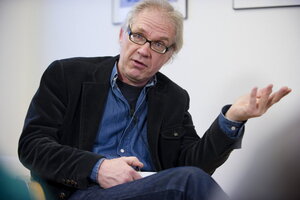'Jihad Jane' alleged target Lars Vilks: 'I have an ax here'
Swedish cartoonist Lars Vilks, allegedly the target of a group led by 'Jihad Jane,' relies on international policing efforts to stay safe. But safeguards are shifting as European views evolve on free speech and blasphemy.

Swedish artist Lars Vilks during an interview in Stockholm, Sweden, Wednesday March 10. Mr. Vilks says he believes the suspects arrested in Ireland and the U.S. in an alleged plot to kill him were not professionals.
Bertil Ericson/Scanpix/AP
Atlanta
Swedish cartoonist Lars Vilks, the alleged target of a group of would-be Islamist terrorists led by a Philadelphia woman known as "Jihad Jane," says he wasn’t “shaking with fear, exactly,” after he learned of the plot.
But the gray-haired cartoonist told the Swedish wire service TT that he didn’t rely entirely on Swedish and international intelligence agencies to keep him safe, either. He kept an ax next to his bed and said he “had prepared in other ways.”
Colleen LaRose, the Philadelphia woman also known as "Fatima LaRose" and "Jihad Jane," and seven co-conspirators in Ireland were arrested Tuesday for planning to assassinate Mr. Vilks. The arrests came three months after Danish cartoonist Kurt Westergaard, who had depicted the prophet Muhammad as a suicide bomber, narrowly escaped assassination by hiding with his daughter in a specially built “panic room.”
In solidarity with Vilks and in support of European press freedoms, three Swedish newspapers on Wednesday republished the 2007 cartoon of Muhammad as a stray dog, which Vilks intended as an editorial comment on self-censorship, freedom of expression, and religion.
At the same time, European artists realize that the ground is shifting in Europe as views evolve on art, free speech, and blasphemy, sometimes resulting in bans on criticisms of Islam.
While Swedish Prime Minister Fredrik Reinfeldt defended Vilks’ cartoons in 2007 by saying Swedes “are eager to stand up for freedom of expression … [which] comes naturally to us,” others say artists like Vilks can actually expect a timid defense of their right to criticize religious beliefs and icons.
“Shockingly, most European journalistic commentary argued that Western writers and artists should, for prudence sake, abstain from such expression” after the attack on Mr. Westergaard, writes conservative commentator Tony Blankley, author of “The West’s Last Chance.”
Even as prosecutions against those planning attacks on European artists have increased in recent years, blashemy laws have also tightened in Europe. In one such case in 2008, Dutch prosecutors arrested cartoonist Gregorius Nekschot for a cartoon he drew cariacturing fundamentalists meeting at an antigay rally.
“The ‘Free World,’ it appears, may be losing faith in free speech,” wrote George Washington University law professor Jonathan Turley in a column last year.
Vilks, who became well-known in Sweden in the 1990s after attempting to establish the sovereign country of Ladonia in order to stage an art exhibit, lives in a rural area of southern Sweden. He told TT in 2007 that “[I am] an easy target if it came to it.” But he added, “I know that there are some risks involved, but one shouldn’t exaggerate them, either.”
While vigilant, Vilks hasn’t lost his sense of humor. After the group Islamic State of Iraq put a $100,000 bounty on him in 2007, he told reporters: "I suppose this makes my art project a bit more serious. It's also good to know how much one is worth."
But the "Jihad Jane" arrest is still an uncomfortable reminder that as the ideas of free speech and blasphemy evolve in increasingly multicultural Europe, terror targets such as Westergaard have changed their views on art and survival.
“I have turned fear into anger and indignation,” Westergaard said in 2008.
